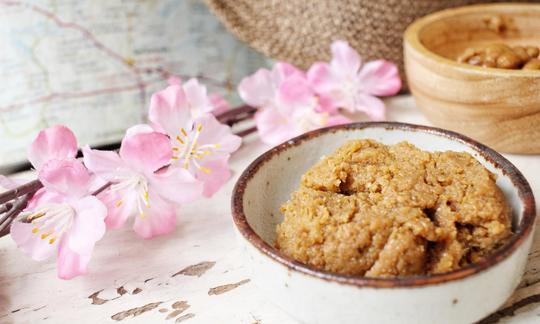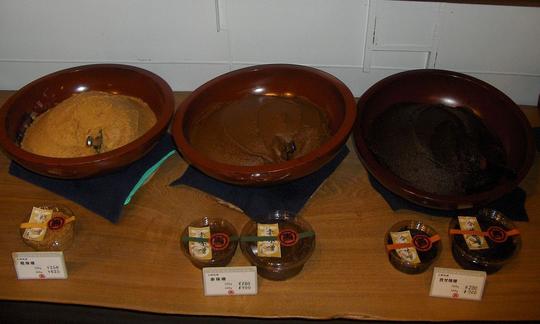Table of contents
Miso is a paste made from soybeans that is used in Japanese cuisine for soups and stews and as a seasoning.
Use in the kitchen
What is miso paste? The thick paste is a Japanese seasoning made from fermented soybeans, salt and sometimes rice or grains. There are different types of miso that differ in composition and fermentation time and therefore have different tastes and colors. Miso can be used as a natural flavor enhancer and as a substitute for table salt or vegetable broth.
What does miso paste taste like? Miso is salty and savory (umami), and the taste ranges from spicy to sweet depending on the variety. The taste is sometimes reminiscent of fermented beans.
Soybean paste is mostly used in Far Eastern dishes, especially in Japanese cuisine. The most well-known dish is miso soup. Sweeter types of miso are used as a glaze for mochi and dango (small rice balls) or for ice cream.
If you use miso as a soup base, you should not cook it, as this will destroy the healthy microorganisms it contains. You should only add the miso at the end or just heat the dish slightly, as in Jerusalem artichoke and parsnip soup or cash-mi soup. It tastes good as a seasoning not only in cashew cheese, but also as a miso glaze on baked eggplant. The glaze can also be used for other vegetables, such as zucchini, sweet potatoes and carrots.
Making your own
To make miso at home, you need a koji mold culture, which is easiest to buy in online shops. The miso is best stored in a glass container with straight walls. You also need cedar wood chips and (ceramic) weights. 9
Before preparing the miso, soak the soybeans in water for at least 12 hours. Drain the water and simmer the beans in a pot with new water over a low heat until they are soft. Drain the water and save at least 500 ml of the cooking liquid. Allow the cooking water and the beans to cool (approx. 40-50 °C) so that the mold does not die. At the same time, you should soak the cedar planks in the water so that they do not absorb too much moisture from the miso later. 9
When the beans have cooled down (not cold), puree them in a blender. Break the koji apart, mix with salt and add to the soybean puree. Depending on the type of miso and the planned fermentation time, the miso requires different amounts of salt. An overview table can be found at this link. From the calculated amount of salt, take 3-4 tablespoons off, which you will need later. The miso should be doughy and moist, but not wet. To do this, gradually add the saved cooking water to the soybean-salt-koji mixture in small amounts, knead the mixture and leave to stand for a few minutes. To assess the consistency, you must wait at least 30 minutes. Repeat this until it has the desired consistency. 9
Clean the container thoroughly. Swirl it with water and sprinkle the inside with some of the salt you set aside. Pour the miso into the glass. Press down firmly so that there are no air pockets. When all the miso is in the container, you must thoroughly clean the remaining inside with a kitchen towel moistened with alcohol. Smooth the surface of the miso well and sprinkle with the remaining weighed salt. It is more important that everything is covered with salt than that the amount of salt is accurate to the gram; if in doubt, add another tablespoon of salt. 9
Place the soaked cedar planks on the salted surface. Place at least one kilo of weight on top (e.g. ceramic weights). Without sufficient weight, the miso will not ferment well. Cover the container with a clean kitchen towel, which is attached to the edge with an elastic band. Miso needs darkness to ferment, so the kitchen towel should cover the container completely. 9
Store the container with the miso at 18°-20°C and check the fermentation every few days. After 3 to 4 weeks, a brown liquid should appear on the surface of the miso around the cedar wood chips. This shows that the fermentation is progressing as desired. If no liquid has formed, then you should put more weight on the miso and wait a few days longer. Some miso manufacturers recommend unpacking the miso after 3 months and stirring it. It is important that you repack the miso well afterwards. 9
Depending on the type of miso, the fermentation period can be several months or two years. As soon as the miso is ready, you can pour it into screw-top jars and store it in the refrigerator. The cold stops the fermentation, which preserves the miso. If necessary, you can also puree the miso beforehand with a hand blender to get a smoother texture. 9
Vegan recipe for tzatziki with miso
Ingredients (for 2 people): 250 g cucumber, 1 clove of garlic, 3 tbsp miso paste, 1 cup soy yoghurt (natural, unsweetened), 1 tbsp lemon juice,black pepper.
Preparation: Wash the cucumber and cut into fine cubes. If the cucumber has coarse seeds, remove them first. Drain the cucumber cubes in a sieve for 20 minutes. Peel the garlic cloves and press them through a garlic press or chop them finely with a knife. Mix the miso with the cucumber, garlic and lemon juice in the soy yoghurt. Season with pepper.
Vegan recipes with miso can be found under the note: " Recipes that have the most of this ingredient ".
| Not only vegans or vegetarians should read this: Vegans often eat unhealthily. Avoidable nutritional errors. |
Purchasing - Storage
Miso paste is sold in plastic bags or jars. You can usually buy miso in organic supermarkets such as Denn's Biomarkt or Alnatura, health food stores, as well as in Asian shops and online shops. Occasionally you can find miso paste in large supermarket chains such as Coop, Migros, Spar, Rewe, Edeka or Hofer, sometimes even in organic quality. You can often buy miso soup packages that contain miso powder, dried seaweed and tofu pieces and that you only have to mix with water. Other supermarkets such as Aldi, Denner, Volg, Lidl and Billa rarely have miso on offer.
Miso is not a raw food, as the soybeans are heated during production. Unpasteurized miso is therefore simply cooked food that has been "revived" through fermentation.
The availability of miso in the supermarkets mentioned varies depending on the size of the store, catchment area, etc. If you are interested, click on our recorded food prices for the DA-CH countries (above under the ingredient image). There you will find current prices from various supermarkets and their price development.
Storage tips
Thanks to its high salt content and fermentation, miso can be stored in an airtight container in the refrigerator for up to two years after opening the package. 15 It is important to always use clean cutlery to remove the paste from the container so that no germs can get into it.
Ingredients - Nutritional values - Calories
Miso (organic) contains 198 kcal per 100 g. The fat content is moderate at 6.0 g/100g. The protein content is medium at 13 g/100g. The carbohydrate content is 25 g/100g. 1
The high salt content is striking at 9469 mg/100g. For a portion of miso soup, you usually use 1 tablespoon, which is about 17 g. This means you consume 1.61 g of salt. With a recommended daily amount of 6 g of salt, this corresponds to 26.83%. 1
Miso paste, like the soybeans from which it is made, contains all the essential amino acids. However, the content is lower than in unprocessed beans and only small amounts of miso should be consumed daily, which is why the actual amount consumed is not very large and the requirement must be covered with other foods. The soy paste contains the amino acids tryptophan (0.16 g/100g) and threonine (0.48 g/100g). With 10 g of miso, you cover 6.3% and 5.2% of the daily requirement for these essential amino acids. High levels of Tryptophan is found in dried porcini mushrooms at 1.5 g/100 g. Threonine is found in large quantities in brewer's yeast (2.7 g) and spirulina (3.0 g). 1
Also included is 0.86 mg/100g of manganese. A good source of manganese is wheat germ with 13 mg/100g. 1
Does miso contain vitamin B12? Vitamin B12 (cobalamin) is present in miso at 0.08 µg/100g. This value is comparable to the cobalamin content ofbaking yeast (0.07 µg/100g). Yeast flakes are good sources of vitamin B12 at 2 µg/100g. 1
You can find all the ingredients of miso, how much it covers your daily needs and comparison values with other ingredients in our nutrient tables below the ingredient image.
Health effects
Is miso healthy? Fermented products such as miso are considered healthy. Various studies have discussed the potential health benefits of consuming traditional fermented foods. 12,13 However, the mechanisms by which fermented foods provide these health benefits are still the subject of current research. 11 Due to the fermentation process, unpasteurized miso contains numerous bacteria that are beneficial to health. Miso is therefore often said to have probiotic effects. However, no study has yet been able to provide evidence of probiotic microorganisms according to the WHO standard for miso (as of 2021). 11
Observational studies from Japan suggest that a higher intake of fermented soy products, particularly natto and miso, is associated with a lower risk of mortality. 14 It has also been shown that people who consumed miso soup daily were less likely to suffer from gastroesophageal reflux disease than those who only ate miso soup occasionally. 10
Miso also contains isoflavones. Their effect on the body has not yet been fully clarified. While certain studies show health benefits in the consumption of isoflavones, other studies show the opposite. You can find out more about this under the ingredient tofu.
Dangers - Intolerances - Side effects
Miso consists of soy, which is one of the 14 main allergens. 5 People with a soy allergy should therefore not eat miso. People who are allergic to flower pollen must also be careful, as a cross-allergy can occur. 6
The high salt content in miso should not be underestimated (more on this in the ingredients chapter). However, studies show that consuming salt in the form of miso soup does not increase blood pressure compared to equivalent salt intake. 7,8 In addition, clinical observational studies have shown that there is no connection between the frequency of consumption of miso soup and blood pressure levels or high blood pressure. 7 It has been shown that the ingredients in miso weaken sympathetic nerve activity, which leads to lower blood pressure and a lower heart rate. 7 It should be noted that these studies were conducted in Japan, where the study participants may have been consuming miso for decades. The extent to which the results can be applied to people who have recently started consuming miso has not yet been investigated. Moderate consumption of miso is therefore recommended due to the high salt content.
Risk of confusion
In addition to miso, there are other soybean pastes, such as the Korean paste doenjang. In contrast to miso, doenjang is made only from soybeans and salt water and is fermented spontaneously using a mixture of fungal and bacterial cultures. In contrast, miso is fermented under controlled conditions using the koji mold. Several East, South and Southeast Asian countries have similar fermented soybean pastes.
Ecological footprint - animal welfare
Miso usually consists of soybeans, salt and kōji (see "Industrial production"). Production takes place in several steps and includes the production of the kōji, for which a substrate is mixed with mold cultures and then left to ferment. This is followed by steaming or boiling the soybeans so that they can be cooled and mixed with the kōji. The subsequent fermentation can take up to 2 years. 16 The ecological footprint and water consumption of miso is made up of the individual ingredients and individual production steps as well as packaging and transport and varies greatly. The main ingredient, soy, has fallen into disrepute in recent years due to large-scale deforestation of rainforests in South America for monocultures. 17 In tropical climates, this plant is also very susceptible to pests, which is why herbicides are used on a large scale in these countries. 18 However, it should be borne in mind that 76% of the world's soy harvest ends up as animal feed in milk and meat production (2017-2019), and only 20% of soybeans and the products made from them are used directly by humans. 19 No rainforests have to be cleared for this, because soybeans are also grown in Europe, often in organic farming that does not use pesticides or herbicides. Accordingly, when shopping, it is best to buy regional, organic miso paste. The packaging for miso is usually plastic or disposable glass, with plastic packaging proving to be a more environmentally friendly option. The production and melting of glass requires a lot of energy and produces correspondingly high CO2 emissions. The weight during transport also has a negative impact. 20 Plastic packaging is lighter and allows the paste to be taken out in portions, which can prevent it from spoiling quickly.
Worldwide occurrence - cultivation
Miso probably originated in China and from there reached Japan, where the soy paste has been produced and used in cooking since the 6th century. 11
Miso is also popular outside Asia. Japan exported 16,000 tons of miso worldwide in 2017, an increase of 470% compared to 2,800 tons of miso exported in 1990. 11 There are also increasing numbers of miso producers in Europe and the USA.
Industrial production
Miso production involves a two-stage fermentation process in which a substrate (rice, barley or other grain) is first inoculated with the kōji mold culture ( Aspergillus flavus var. oryzae) to produce 'kōji'. Kōji is then mixed with soybean pulp and salt, and this mixture ('miso') is left to ferment for up to 2 years. 11 In traditional production, the mass is fermented in cedar barrels that are weighted down with stones. 4 Today, industrial production of miso mostly takes place in solid-state bioreactors.
While in 1945 55% of all Japanese miso production was homemade miso in individual households, by 1980 around 90% of miso was produced commercially. Commercial miso production began in the 1960s when methods were developed to standardize miso production and inoculate it with commercial mold cultures. This made it possible to produce a consistent product that could be produced commercially on a large scale. 11
Further information
The Kōji mold ( Aspergillus flavus var. oryzae), which is used to make miso, is also used to make tera-natto (fermented soybeans) 3, sake and shōchū (Japanese spirits), soy sauce and rice vinegar. 2
Bibliography - 20 Sources
| 1. | USDA United States Department of Agriculture. |
| 2. | Pharmawiki.ch. Aspergillus oryzae. |
| 3. | Japanische-lebensmittel.net. Natto. |
| 4. | Japanische-lebensmittel.net. Miso. |
| 5. | Medizinische Universität Wien. Die 14 wichtigsten Allergene. |
| 6. | Bundesinstitut für Risikobewertung. Birkenpollenallergiker können auf Sojaprodukte besonders empfindlich reagieren. 2007. |
| 7. | Ito K. Review of the health benefits of habitual consumption of miso soup: focus on the effects on sympathetic nerve activity, blood pressure, and heart rate. Environ Health Prev Med. 2020 Aug 31;25(1): 45. |
| 8. | Ito K, Miyata K, Mohri M, Origuchi H, Yamamoto H. The Effects of the Habitual Consumption of Miso Soup on the Blood Pressure and Heart Rate of Japanese Adults: A Cross-sectional Study of a Health Examination. Intern Med. 2017;56(1): 23-29. |
| 9. | Fermentation.Love. Miso selber machen. |
| 10. | Mano F et al. Nagahama Study Group. Reduction in Gastroesophageal Reflux Disease Symptoms Is Associated with Miso Soup Intake in a Population-Based Cross-Sectional Study: The Nagahama Study. J Nutr Sci Vitaminol (Tokyo). 2018;64(5): 367-373. |
| 11. | Allwood JG, Wakeling LT, Bean DC. Fermentation and the microbial community of Japanese koji and miso: A review. J Food Sci. 2021 Jun;86(6): 2194-2207. |
| 12. | Marco ML, Sanders ME, Gänzle M, Arrieta MC, Cotter PD, De Vuyst L, Hill C, Holzapfel W, Lebeer S, Merenstein D, Reid G, Wolfe BE, Hutkins R. The International Scientific Association for Probiotics and Prebiotics (ISAPP) consensus statement on fermented foods. Nat Rev Gastroenterol Hepatol. 2021 Mar;18(3): 196-208. |
| 13. | Sanlier N, Gökcen BB, Sezgin AC. Health benefits of fermented foods. Crit Rev Food Sci Nutr. 2019;59(3): 506-527. |
| 14. | Katagiri R, Sawada N, Goto A, Yamaji T, Iwasaki M, Noda M, Iso H, Tsugane S; Japan Public Health Center-based Prospective Study Group. Association of soy and fermented soy product intake with total and cause specific mortality: prospective cohort study. BMJ. 2020 Jan 29;368: m34. |
| 15. | Schwarzwald-miso.de. Miso Basics. |
| 16. | Kusumoto KI, Yamagata Y, Tazawa R, Kitagawa M, Kato T, Isobe K, Kashiwagi Y. Japanese Traditional Miso and Koji Making. J Fungi (Basel). 2021 Jul 20;7(7):579 |
| 17. | WWF Schweiz. Der Sojaboom - Auswirkungen und Lösungswege. 2014. |
| 18. | Bundesinformationszentrum Landwirtschaft. Soja - Nahrungsmittel für Tier und Mensch. |
| 19. | Our Wold in Data. Soy. 2021. |
| 20. | Ghenai C. Life Cycle Assessment of Packaging Materials for Milk and Dairy products. Int. J. of Thermal & Environmental Engineering Volume 4.2012; 117-128 |













Comments